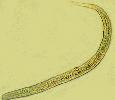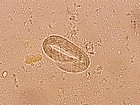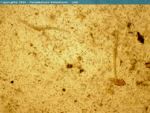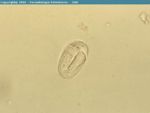Difference between revisions of "Strongyloides"
Jump to navigation
Jump to search
| Line 4: | Line 4: | ||
[[Image:Strongyloides.jpg|thumb|right|150px|''Strongyloides'' - Joaquim Castellà Veterinary Parasitology Universitat Autònoma de Barcelona]] | [[Image:Strongyloides.jpg|thumb|right|150px|''Strongyloides'' - Joaquim Castellà Veterinary Parasitology Universitat Autònoma de Barcelona]] | ||
| − | === '' | + | |
| − | + | ==Overview== | |
| + | This is the only genus of veterinary importance in the super-family Rhabditoidea. There are a number of species that are of particular importance and these are mainly host specific. | ||
| + | |||
| + | |||
| + | === ''Strongyloides westeri'' === | ||
| + | This is a parasite of the horse and is most commonly seen in young foals, less than six months in age. This is usually the fisrt parasite to which foals are exposed and therfore they have very little immunity to these infections. The predeliction site for these worms is the small intestine. | ||
*Rhabditoid, small intestine. | *Rhabditoid, small intestine. | ||
| − | |||
| − | |||
==== Morphology ==== | ==== Morphology ==== | ||
| Line 31: | Line 34: | ||
[[Category:Rhabditoidea]][[Category:To_Do_-_Parasites]] | [[Category:Rhabditoidea]][[Category:To_Do_-_Parasites]] | ||
| + | |||
| + | [[Category:To_Do_-_NickJ]] | ||
Revision as of 10:23, 31 July 2010
Overview
This is the only genus of veterinary importance in the super-family Rhabditoidea. There are a number of species that are of particular importance and these are mainly host specific.
Strongyloides westeri
This is a parasite of the horse and is most commonly seen in young foals, less than six months in age. This is usually the fisrt parasite to which foals are exposed and therfore they have very little immunity to these infections. The predeliction site for these worms is the small intestine.
- Rhabditoid, small intestine.
Morphology
- <6mm long, similar to small trichostrongyles.
- Only female worms parasitic.
- Long oesophagus (up to one third of body length).
Life-Cycle
- Parasitic and free-living (non-parasitic) phases.
- Prepatent period 1week (embryonated egg, 50-60µm).
- Infection by:
- ingestion of L3 in mare's milk or grass; and
- skin penetration.
Pathogenicity
- Foals - severe enteritis, diarrhoea (heavy burdens).
- Adults - normally immune; may act as carriers, e.g. mare.
Control
- Regular anthelmintic treatment.
- Good hygiene.



